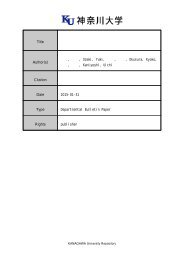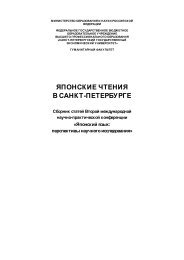to Learners with Special Educational Needs
e-textbook SEN
e-textbook SEN
You also want an ePaper? Increase the reach of your titles
YUMPU automatically turns print PDFs into web optimized ePapers that Google loves.
Pokrivčáková, S. et al. (2015). Teaching Foreign Languages <strong>to</strong> <strong>Learners</strong> <strong>with</strong> <strong>Special</strong> <strong>Educational</strong> <strong>Needs</strong>:<br />
e-textbook for foreign language teachers. Nitra: Constantine the Philosopher University. 128 p.<br />
ISBN 978-80-558-0941-0<br />
Forms of educating gifted children<br />
The most common forms for educating gifted pupils are:<br />
acceleration,<br />
enrichment,<br />
early entrance <strong>to</strong> primary school,<br />
skipping classes,<br />
absolving chosen subjects <strong>with</strong> higher grades,<br />
choice of more difficult optional subjects,<br />
creation of individual plans for subjects where the child is exceptional (Hribkova, 2009).<br />
Among these, acceleration and enrichment are the most frequent. Acceleration is more<br />
spread in gifted education in many countries around the world. Enrichment is the preferred<br />
approach in Slovakia (Reid & Boettger, 2015). However, both varieties are often combined, as<br />
acceleration can be enriching and enrichment can lead <strong>to</strong> acceleration.<br />
The problem <strong>with</strong> acceleration is that even though the gifted children can cope cognitively<br />
<strong>with</strong> older children, but they are at different levels of emotional maturity. Enrichment aims <strong>to</strong><br />
deepen the contents of existing subjects. Enrichment can be carried out in both regular and<br />
segregated classes. In regular classes, gifted children can manage in the same time greater<br />
amount of work (deepening the <strong>to</strong>pic) than other children. The key competences specified in the<br />
national curriculum are the same for regular and gifted pupils. The same standards should<br />
guarantee the compatibility of all schools (VÚDPaP, 2009). That is why enrichment is the more<br />
common and preferred way of educating gifted children in Slovakia.<br />
Teaching techniques in gifted education<br />
Teaching techniques for gifted children should lead <strong>to</strong> discovering, active searching, active<br />
acquiring and active formation of information, knowledge and skills. All techniques should<br />
connect learning <strong>to</strong> real life situations, experiences and humour should not be missing. Teaching<br />
gifted children should integrate multi disciplines in<strong>to</strong> the area of study <strong>with</strong> the aim <strong>to</strong> get<br />
complex information, connect ideas, his<strong>to</strong>rical background, etc. CLIL (Content language<br />
integrated learning) would be a very suitable method for teaching gifted pupils as it promotes<br />
mixing mother language and foreign language in a lesson instead of teaching subjects´ contents<br />
only in one language (Pokrivčáková, 2013). Techniques such as drilling, application of many<br />
simple tasks, memorizing, application of rules and knowledge <strong>with</strong>out knowing the background,<br />
application of non-creative and non-problematic tasks should be minimized or avoided<br />
(Jurašková, 2003; Lazniba<strong>to</strong>vá, 2012; Bevan-Brown, Taylor, 2008). Here are some suggestions<br />
for working <strong>with</strong> gifted pupils:<br />
1. Discovery techniques – teachers do not explain <strong>to</strong> pupils everything, but allow pupils <strong>to</strong><br />
work out by themselves rules and solutions <strong>to</strong> the problem. Pupils are encouraged <strong>to</strong> create<br />
their own constructs and answers. For solving the problematic tasks, pupils need <strong>to</strong> apply<br />
previous knowledge, predict and elicit new rules, apply intuition and risk taking. Teachers<br />
should create such situation that would lead pupils <strong>to</strong> work out and acquire new rules,<br />
knowledge and skills.<br />
In English lessons, the discovery techniques could be used for example for teaching grammar<br />
(e.g. comparatives and superlatives “tall/taller/tallest”. Fourth graders know the word “tall”, but<br />
do not know the comparative and superlative forms. A teacher picks three pupils of a different<br />
height and asks the rest of pupils “Who is the tallest?” (A pupil is the tallest.) Even though the<br />
pupils do not know the form “tallest”, they can work out the meaning. The comparative form<br />
“taller” is also applied in comparison <strong>with</strong> the other two pupils (Is A pupil taller than B pupil? Is<br />
C pupil taller than B pupil? Are A and B pupils taller than C pupil?). With this technique pupils<br />
discover the grammatical rule and figure out the pattern for themselves. The teacher´s role is <strong>to</strong><br />
guide pupils <strong>to</strong> their own discovery, not <strong>to</strong> give them information on the grammatical rule. Such<br />
118






